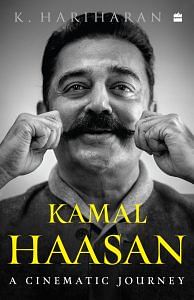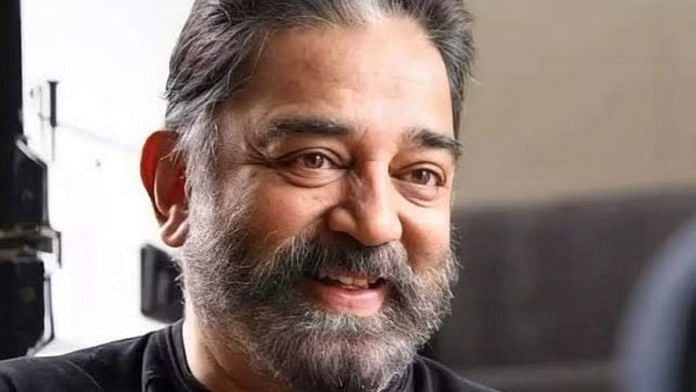Few children could have been as precocious as young Kamal Haasan. Born almost twenty-five years after his parents’ marriage, much after his other siblings, he was everybody’s darling; not only his relatives but also the people in the small town of Paramakudi, where the family was well known. The days leading to Kamal’s birth were fraught with tension, almost as dramatic as some of his films. When his mother, Rajalakshmi, went into labour, his father, D. Srinivasan, a reputed lawyer, realized that his wife could face complications due to her diabetic condition.
She was overweight and short of breath. She was rushed to the local hospital for delivery where the rather inexperienced doctor looked at her sceptically and declared that a normal birth would be impossible, as both the baby’s and the mother’s lives would be at risk. But there was no alternative. After many long hours of labour, Kamal was born, a big baby with a fat umbilical cord. The doctor gave Kamal’s elder sister Nalini the task of monitoring the baby’s condition, while his mother was taken away for an emergency post-delivery operative procedure.
Nalini was just over eight years old and had no clue how to take care of a newborn. Charuhasan, Kamal’s older brother, and his wife, Komala, were waiting in the corridor of the small maternity clinic when they saw a big bundledup baby being carried to another room by the nurse. He recalls, ‘Kamal was huge, pink and a bit scary. My mother, fearing that she might not survive the delivery, had recently got me married to this highly educated girl from Madras. On seeing this baby, my newly wedded wife did not know how to react.
She was probably wondering what kind of family she had married into!’ It is said that newborns start responding to sounds first and after that, they open their eyes slowly and start watching the world around. It is also supposed to take about three to six weeks for a baby to recognize people and its surroundings. But Kamal responded to the sounds around him and even started noticing Nalini’s moving fingers when he was only three days old. It was spooky. The nurses told Nalini that since her mother had had high sugar levels during her pregnancy, the baby had developed levels of sensibility comparable to a three-month-old in the womb itself. Although this may be debatable from a scientific point of view, Nalini recalls that Kamal was quite alert for an infant.
Rajalakshmi was a fighter and somehow survived the post-delivery complications. She lived till the age of sixty-eight. For everybody else in Paramakudi, this birth in the Srinivasan household was a miracle. Nalini has an interesting story to narrate about the post-birth days: ‘Although Kamal does not believe in God, I believe that his survival was due to divine intervention. Having escaped the jaws of death, my mother was seen as someone intimately blessed by the Almighty. Soon, several pregnant women in the neighbourhood started coming by to seek my mother’s blessings!’ Kamal’s father Srinivasan’s childhood was disrupted when his own father died very young. When Kamal’s grandfather was on his deathbed, he requested his father-in-law, Srinivasan’s maternal grandfather, to bring up all his six children and teach them to become good citizens.
Being a lawyer himself, the grandfather wanted young Srinivasan and his brother to study law after completing their schooling. Srinivasan, however, was not interested. He was inspired by his grandfather’s client, the prince of Pandanallur, who was a dance aficionado. After watching stellar performances in the prince’s reputed durbar, Srinivasan became interested in studying vocal music and even attended several classes without anybody’s knowledge. It was not long before the news of his clandestine music tuitions reached his grandfather’s chambers. The family was aghast to find out that Srinivasan had neglected his studies to pursue something which had no hopes of any monetary returns whatsoever. They summoned him and ransacked his small cupboard to discover the music notebook that he had so carefully preserved. While they didn’t beat the boy, they tore the notebook to shreds and flung it onto the street outside. Srinivasan, just ten years old at that time, picked up the torn pieces and shouted, ‘I will obey you now, but let me assure you of one thing. I won’t let this happen in my house. One day I too will have kids and I will see to it that all my children grow up to become musicians and artistes. Wait and watch!’
Almost everybody in Srinivasan’s family did turn out to be artistes. Nalini learnt dancing, partially to fulfil her father’s dream. When young Kamal expressed his complete disgust for routine academics, his father was the happiest and encouraged him to pursue performing arts. This was way back in 1966, when it was compulsory for every middle-class Indian child to at least complete their graduation. Even Kamal’s elder brothers, who had taken up law, were excited rather than unhappy to see how this maverick would turn out as an ‘artiste’ with no formal education. As a child, Kamal met some highly inspiring personalities.
Visitors to the Paramakudi home included senior Congress stalwarts such as C. Rajagopalachari and K. Kamaraj. Srinivasan would insist that the women of the house come out of the inner chambers to the front room to meet and talk with these prominent figures. There was no resistance from Rajalakshmi either when these freedom fighters would freely move around the interiors of the main house, unlike the norm where outsiders were not allowed into inner rooms. She used to cook huge quantities of food for them, to be served as ‘samapandhi bhojanam’ (lunch for a crowd).
One day Srinivasan invited P. Kakkan, another freedom activist and Dalit leader, into the kitchen area.
His orthodox Brahmin aunts did not seem to be affected by this ingression. After Kakkan left, curious neighbours asked them how they could admit a low-caste man into the kitchen. An old aunt replied quite casually, ‘Hey, these kinds of people have no caste at all, they are freedom fighters and therefore belong to the nation.’ Srinivasan’s spirit of nationalism was indeed infectious, affecting even the seventy-year-old grandaunt! There was not a single family in Paramakudi who did not know Kamal. He would take the liberty of walking into any house at any time, receiving mixed reactions! He was capable of enthralling people with his antics, but would also leave behind a trail of damaged windowpanes and broken pots. One day, their neighbourhood doctor brought Kamal home with his right palm all bandaged up.
Before the child could be admonished, the doctor said that the little boy was the bravest patient he had ever seen. He was the first patient to sit through six stitches without emitting even a whimper! The real story—that Kamal had gone to the doctor’s house and experimented with his brand-new shaving razor, which had led to the cut—was told much later. Kamal’s curiosity regarding films was satiated by a member of his house staff, with surreptitious visits to the old thatched cinema talkies. Under the pretext of taking care of him, the worker would get him to watch all of M.G. Ramachandran’s and Sivaji Ganesan’s movies. An enthralled Kamal would come home quoting the films’ dialogues and earnestly mimicking all the actions.
 This excerpt from K. Hariharan’s ‘Kamal Haasan: A Cinematic Journey’ has been published with permission from HarperCollins India.
This excerpt from K. Hariharan’s ‘Kamal Haasan: A Cinematic Journey’ has been published with permission from HarperCollins India.






